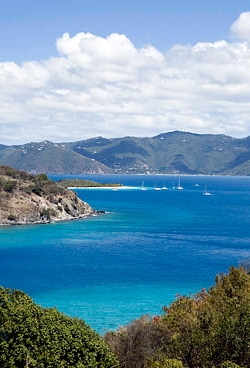Virgin Territory
The summit arrives quickly. At the end of my 800-yard climb up a rutted trail, I take a last step onto a wooden platform that rises above the forest. Here the British Virgin Islands are mine alone, a heady 360-degree kingdom of stepping stones and foamy reefs. Atop Gorda Peak, Virgin Gorda's 1,370-foot summit, the sea breeze strums the canopy to produce creaking as soothing as a rocking chair's. In the distance, I see thumbnail-sized sailboats ply across blue butter, their passengers oblivious to the panorama before me. Down on the water, they'll never be able to see the BVI like I do right now.
Many of the visitors who arrive here explore the BVI on sailing charters. They flit among the principal islands — Tortola, Anegada and Virgin Gorda — as well as more than 50 other islands, cays and rocks huddled close together. I can't look to any horizon without white sails reminding me of an explosion in a handkerchief factory. But as traveled as the BVI are by sea, much remains hidden on land.
My love for the sea is as deep as anyone's, but I know that you can miss things from the water. That includes stable ground and a rest- room that doesn't announce your intentions to the world, yes, but also fairy forests in the gloaming, hidden swimming holes and a cab driver's patois of life advice. I also know it is a mistake to think you know anything well — even if it's a scattering of Caribbean islands — for life is rife with surprises, and often all it takes is a fresh path to unveil them. So damn the wind and stow the spinnaker! I came to the BVI for the journey inward, away from countless moorings, marinas and beaches and into the unseen places.
The first thing I discovered on arriving at Tortola's airport was Moviene Fahie. This local guide would be my cab driver rather than ship captain. She swept up my heavy duffel bag into her taxi as if it were a coconut. On the drive toward the Sugar Mill Hotel on the north shore of Apple Bay, the smell of the sea blew through my open window. We passed a small beachfront bar, Bomba's Surfside Shack. It looked as if it had been assembled from flotsam that had washed ashore, had collapsed once or twice and been reassembled by patrons after happy hour. What caught my attention was a pair of industrial sized panties waving in the breeze. "Bomba's — crazy place," Moviene said in her English-Creole accent. She talked of the bar's infamous psychoactive mushroom tea. "If you have one of those drinks, you can walk to Aruba." Watching me in the rear view mirror, she wagged a finger: "Stick to rum."
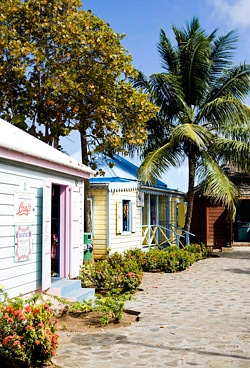
The following morning Moviene picked me up at the hotel at 8 sharp, and off we went. Since my aim was to explore Tortola's interior, that's where we headed, climbing narrow roads twisting high into the sky, hemmed in by wandering goats and scrubby brush. We drove through the Fahie Hill community, making our way slowly past a series of murals painted on a concrete wall beside the road.
"Look at the paintings," Moviene commanded.
One Fahie Hill mural shows men loading bags of sand onto burros, families terracing the land for crops and a boy ushering cows through a chute of wood fencing. Moviene nodded to this last painting. "Have to get the tit off," she said.
I stared at the painting, feeling great pity for the cows. Finally it dawned on me: "They're getting the ticks off."
"You must be a farm-ah!" Moviene said, laughing.
Just down the road we stopped at another mural, this one tucked inside a breezy open-air pavilion facing the distant sea. The mural depicted a lovely, long-ago scene of the community gathered upon a common green shaded by great trees and backed by a handker- chief-less sea, people socializing the way they did before we with- drew into our own narrow lives. Adults gossiped; children and music played. Finished admiring the mural, I sat on an adjacent bench and admired the current scene. A knot of men played cards in the shade of a great tree. Three elderly women dressed in their Sunday finery on this Friday carried on an animated conversation, possibly about the gambling men. I took it all in, happy to be a landlubber.
For several days Moviene showed me around Tortola. One afternoon she dropped me off in Road Town, the capital of the BVI. Its streets were crowded, and people spilled from banks, offices and shops. Everywhere people hustled about, as people in cities do, but many of them smiled at each other and exchanged greetings.
I am not a fan of stopping strangers on the street, but I had to know why everyone was so cordial. I stopped the friendliest man I saw and asked him. He smiled at me with a shadow of pity. "You live in the other world," he said. "We live in this."
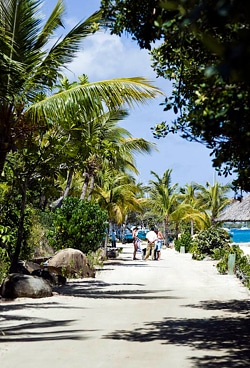
When I returned to the car, Moviene was selling a bag of sweet potatoes through the car window. Farming provides Moviene more of a living than escorting the rare traveler who, like me, wants to actually drive around. Either way, though, her focus was on the land. "You cannot just put plants in the ground," she told me. "They need to be nurtured."
On my third day, Moviene delivered me to Tortola's Sage Mountain National Park, home to the BVI's highest point at 1,716 feet. The sole sign pointing the way to the summit looks as if it hosted a buffet for termites — all the better to keep this route to one's self. It's a wonderful hike, affording cloistered rainforest serenity and, on clear days, seascapes of pale blue.
Unfortunately, this particular day was not clear; foggy cloud banks ran up the slopes, lending Sage Mountain a fetching, Jurassic Park air. The hiking was still enjoyable. Thick, high canopied forest closed about me in a humid embrace, and leaves fell with an entrancing slowness that, like many things in the BVI, snubbed the world's rush. When I reached the highest ground in all the land, it was marked only by two army-green benches and the wind applauding in the trees. The only other people I saw here were two lovers who clearly expected no one else to come along. When I mentioned the lovers back at the car, Moviene clucked approvingly: "One cent can't jingle alone. Two cents in the bag jingle."
For the terra-firma adventurer, the BVI can be mildly maddening. Every time you top a rise like Sage Mountain's, a great scattering of islands appears, and human nature being what it is, you wonder, "Is it better over there?"
Not better, but always different. Moviene had shown me what she could on Tortola. She deposited me at Trellis Bay Marina, but not before watching me walk down the dock and board the proper boat for the 15-minute ride to Guana Island.
I had been told that this privately owned resort island had played host to its share of celebrity guests, but what mattered to me was Guana's wilderness renown. Away from the understated accommodations, which have a cap of about 30 guests at a time, roughly 65 percent of the 850-acre island has been left alone. It remains pristine enough that scientists make regular pilgrimages to the place to study the flora and fauna, though possibly they might enjoy lolling upon empty beaches and dining on sautéed yellowtail snapper, too.
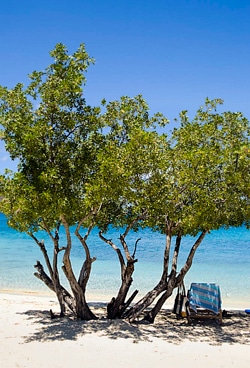
Here on Guana, I decided to hike to Chicken Rock, an outcropping off the northwest point of the island. One of the guests shook her head adamantly: "Ohhhhh, I wouldn't go to Chicken Rock. It's far too far." Much easier would have been to speed across the water on the resort's 68-foot power yacht.
I had already consulted the trail map; an hour's hike did not seem much to see a rock shaped like a chicken. Such opportunity presents itself once in a lifetime. Whoever said the adventure is in the journey — maybe it was Moviene — was very wise. The hike to Chicken Rock was glorious. The trail rose and fell beneath an understory of tamarind, pisonia, gumbo-limbo and royal poinciana. Many of the trees sprouted showy flowers — snow whites, sensual reds and cheery yellows — and even more branches supported epiphytes, the socalled "air plants" that exist upon the boughs of their host. Orchids perched everywhere. In the silence, snakes (harmless) announced their travels with a dry scratching. One — thumb-thick, dark and 2 feet long — moved to cross the trail. When I stood still to watch it pass, it paused to watch me, its sides inflating and collapsing with implausible delicacy.
I have always had bad luck seeing shapes in rocks, but I will tell you that Chicken Rock looks exactly like a chicken. It squats upon dark volcanic rock that will never hatch, on a point that juts into the Caribbean Sea. Better still, there is a deep pool at Chicken Rock's base, a pool open to the sea so that all manner of fish mill about in its emerald-blue waters. Volcanic ledges surround the pool, perfect for leaping, arms windmilling, until your breath turns raspy and your arms and legs go rubbery from pulling yourself over the algae-coated rocks again and again. At the near end of the pool the waves have carved a small underwater cavern 10 feet beneath the surface. Hanging upside down from the cavern lip into the water, I could see fish schooling in the shadows while my body swayed to the pulse of the sea.
Boaters could anchor and swim in the pool beneath Chicken Rock, but they could not hike home, sun low on the horizon, through forest infused with sooty gold. That evening I dined on breaded rack of lamb with the other Guana guests. When they asked me how my walk across the land was, I told them, quite honestly, that it was one of the best days of my life.
Those "best days" continued to add up as I ferried from island to island. I loved the salt-washed commute on the BVI's remarkably efficient ferry system; the throbbing of the engines below deck, the decks themselves piled with boxes of fresh vegetables, beer, a hubcap. I was so caught up in those details, I found myself asking repeatedly, "Is this the ferry to Virgin Gorda?" The locals politely answered again and again.
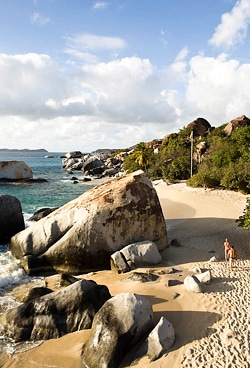
I eventually boarded that ferry. Virgin Gorda, of course, is home to the famed Baths, an astonishing jumble of house-sized granite boulders. The Baths are everybody's must-see — on any given afternoon a flotilla of sailboats anchors offshore and zodiacs buzz in and out from the white-sand beach — but they are also a paean to the path less-traveled.
I waited until just before sunset, as the light and the sailboats both were disappearing. Making my way through the granitic maze, the only sound was the soft slap and gurgle of water against rock. Crabs scurried for cover, and the incoming surge sent fat emerald fingers of water lapping over my bare feet.
Many visitors don't venture beyond the Baths, on the extreme southwestern tip of Virgin Gorda. I actually wanted to see the island as a whole, and the best place to do that is, of course, from atop Gorda Peak, far from shore in the heart of the island. I can no longer imagine a trip to the BVI without that view. To the east of Gorda Peak is the famous Bitter End Yacht Club, a water-sports and sailing mecca for the entire Caribbean, where the handkerchiefs are out in force.
Granted, many of the paths on the BVI — beaten or otherwise — do lead back to the water. But now I have seen the paths that lead to inland wonders. Devil's Bay is not far from the Baths — less than 15 minutes of boulder- scrabbling ups and downs. I hiked there to find a tiny 50-yard cusp of sand pinioned between the famed granite boulders. It was inhabited only by the mildest breeze.
Adventure does not always announce itself with a shout, though I did. I yanked off my shirt, whooped and ran. The Caribbean surged forward in a frothy rush, and I leapt. The waters cupped me firmly and pulled me to the sea. I left my feet and sailed into a world of green.
